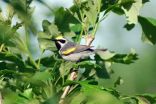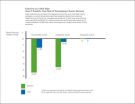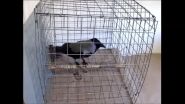What makes kids generous? Neuroscience has some answers
2014-12-18
(Press-News.org) It's no secret that people are judgmental, and young children are no exception. When children witness "good" or "bad" behavior, their brains show an immediate emotional response. But, according to a study appearing in the Cell Press journal Current Biology on December 18, it takes more than that kind of automatic moral evaluation for kids to act with generosity and share their stickers.
By recording kids' brain activity, the study found that generous behavior requires a controlled thought process. The neurodevelopmental findings are the first to link implicit moral evaluations to actual moral behavior and to identify the specific neural markers of each, the developmental neuroscientists say.
"Moral evaluation in preschool children, similar to adults, is complex and constructed from both emotion and cognition," says Jean Decety, a professor of psychology and psychiatry at the University of Chicago. "However, we found that only differences in neural markers of the latter predict actual generosity."
Young children have a reputation for being selfish, and they often are, Decety says. But earlier studies have shown that even infants are sensitive to inequality and that toddlers have the ability to act for the benefit of others. As children grow up, they tend to show an increase in generosity.
To find out where that kind of generosity comes from, Decety and his colleague Jason Cowell monitored the electrical brain activity of children, aged 3 to 5, while they watched helpful and harmful scenes and while they made decisions in the real world about how to treat an unfamiliar child.
Children were given ten stickers and told that the "rewards were theirs to keep." They were informed that the next child to come in wouldn't be given any stickers and then asked if they wanted to give any of theirs to this anonymous other child. If they were feeling generous, the children could place the stickers they were willing to part with into a box while no one was looking.
On average, the children shared a little under two of their ten stickers. The neural evidence indicated that children's moral judgments depended on a combination of early and automatic processing while observing helping and harming scenarios and, later, more thoughtful reappraisal of those scenes. But it was that second step alone that predicted whether a child would share his or her stickers.
The study may offer useful insight for parents this holiday season looking for their children to join in the spirit of giving, Decety suggests. "These findings provide an interesting idea that by encouraging children to reflect upon the moral behavior of others, we may be able to foster generosity," he said.
INFORMATION:
Current Biology, Cowell et al.: "The neuroscience of implicit moral evaluation and its relation to generosity in early childhood"
ELSE PRESS RELEASES FROM THIS DATE:
2014-12-18
Golden-winged warblers apparently knew in advance that a storm that would spawn 84 confirmed tornadoes and kill at least 35 people last spring was coming, according to a report in the Cell Press journal Current Biology on December 18. The birds left the scene well before devastating supercell storms blew in.
The discovery was made quite by accident while researchers were testing whether the warblers, which weigh "less than two nickels," could carry geolocators on their backs. It turns out they can, and much more. With a big storm brewing, the birds took off from their ...
2014-12-18
Many recent studies showed that calorie restrictions reduce the incidence of cancer, whereas high-calorie diets cause obesity and diabetes, both of which increase the risk of developing cancers. However, tumor biology still hides complex mechanisms, as revealed by researchers from the Faculty of Medicine of the University of Geneva (UNIGE), Switzerland. In a study published in Cell Metabolism, scientists not only found the unexpected benefit that a change of diet had on certain types of lung cancer, they also deciphered the molecular mechanism underlying this dietary effect ...
2014-12-18
Berkeley -- When birds unexpectedly flee their nesting grounds, it may be a demonstration of Mother Nature's early-warning system that a massive storm is approaching.
While tracking a population of golden-winged warblers, a research team led by ecologist Henry Streby at the University of California, Berkeley, discovered that birds in the mountains of eastern Tennessee fled their breeding grounds one to two days ahead of the arrival of powerful supercell storms. The storm system swept through the central and southern United States in late April 2014, generating 84 confirmed ...
2014-12-18
This news release is available in Japanese. Behind all motor, sensory and memory functions, calcium ions are in the brain, making those functions possible. Yet neuroscientists do not entirely understand how fast calcium ions reach their targets inside neurons, and how that timing changes neural signaling. Researchers at the Okinawa Institute of Science and Technology Graduate University have determined how the distance from calcium channels to calcium sensors on vesicles affects a neuron's signaling precision and efficacy. In international collaboration with research ...
2014-12-18
Climate change impacts will require major but very uncertain transformations of global agriculture systems by mid-century, according to new research from the International Institute for Applied Systems Analysis.
Climate change will require major transformations in agricultural systems, including increased irrigation and moving production from one region to another, according to the new study, published in the journal Environmental Research Letters. However without careful planning for uncertain climate impacts, the chances of getting adaptation wrong are high, the study ...
2014-12-18
PASADENA, Calif., December 18, 2014 -- Self-reported moderate to vigorous exercise was associated with lower blood pressure and blood glucose levels in a Kaiser Permanente study published in the journal Preventing Chronic Disease. Data collected from Kaiser Permanente's Exercise as a Vital Sign (EVS) program, in which medical office staff asks patients about their exercise habits at every health care visit, revealed associations between moderate to vigorous exercise and improved measures of cardiometabolic health for both men and women. Few previous studies have examined ...
2014-12-18
The part of the brain that tells us the direction to travel when we navigate has been identified by UCL scientists, and the strength of its signal predicts how well people can navigate.
It has long been known that some people are better at navigating than others, but until now it has been unclear why. The latest study, funded by the Wellcome Trust and published in Current Biology, shows that the strength and reliability of 'homing signals' in the human brain vary among people and can predict navigational ability.
In order to successfully navigate to a destination, you ...
2014-12-18
VIDEO:
Research from Univ. of Iowa and Russian scientists show crows are capable of executive-level thinking.
Click here for more information.
Crows have long been heralded for their high intelligence - they can remember faces, use tools and communicate in sophisticated ways.
But a newly published study finds crows also have the brain power to solve higher-order, relational-matching tasks, and they can do so spontaneously. That means crows join humans, apes and monkeys in exhibiting ...
2014-12-18
TORONTO -- Very small segments of genes called "microexons" influence how proteins interact with each other in the nervous system, scientists at the University of Toronto have found, opening up a new line of research into the cause of autism.
The researchers found that microexons are used in neurons by alternative splicing, a process in which a single gene can produce many different proteins. Microexons are pasted -- or spliced -- into gene messengers (mRNAs) to generate forms of proteins that the nervous system needs to function properly. Misregulation of this process, ...
2014-12-18
RESEARCHERS have discovered the unique genetic paths that the childhood brain tumour medulloblastoma follows when the disease comes back, according to research* published in Cancer Cell today (Thursday).
The study - funded by Cancer Research UK, Action Medical Research and others** - shows that taking an extra tumour sample at recurrence, when there are no effective therapies, could identify subsets of patients that might be treatable with existing drugs that target the genetic faults.
The scientists, based at Newcastle University and The Institute of Cancer Research ...
LAST 30 PRESS RELEASES:
[Press-News.org] What makes kids generous? Neuroscience has some answers




